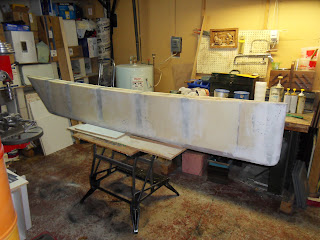J'ai appercu l'automne passé, un trimaran de Piver, dans la cour d'une autre marina, et qui possède ce plan anti-dérive sous sa coque centrale. J'ai pu prendre des mesures afin de reproduire un plan anti-dérive similaire sous mon voilier.
Je fabrique le mien de facon extremmement robuste car je souhaite pouvoir faire déposer mon bateau directement au sol sans son ber, le jour ou je devrai terminer la finition des dessous des sections reliant la coque centrale aux coques latérales. Les patins du ber, sur lesquels le voilier repose, nuisent au travail sous cette section. Mon plan anti-dérive devra donc supporter pratiquement tout le poids du voilier. Sa fixation sous la coque centrale, doit aussi supporter les contraintes latérales normales provenant de la navigation, ainsi que des contraintes latérales exceptionelles telles que celles qui pourraient résulter d'un échouement.
Je concois donc mon plan anti-dérive avec cinq ancrages en alliage d'aluminium, chacun fixé sous la quille de la coque centrale qui est faite en chene blanc, a l'aide de deux grandes vis de gros calibre, des 1/2"-13 en inox, chacune ayant une résistance en tension de 10,000 lbs environ. Je planifie faire passer ces vis au travers de la quille et des grandes rondelles ou meme des plaques également en inox, serviront a répartir l'effort de compression sur la pièce formant la quille a l'intérieur du bateau.
----------------------------------------------------------------------------------
Last fall, I made a plastic pattern according to the shape of the bottom of the center hull under the boat. It's because I intent to make and install a centerboard under the boat. As I said in a previous entry, that centerboard is highly recommended for multihulls boats like mine, by naval architects. Combined with an oversized rudder that goes deep underwater, it gives to the boat a better directional stability, contributes in reducing risks of broaching in bad weather, plus it greatly improves the ability of the boat to make sail close hauled.
Last fall, I spotted another Piver trimaran, in the yard of a nearby marina, that was equipped with such centerboard. I was able to take some measurements in order to reproduce a similar centerboard under my own sailboat.
I build mine in a very sturdy way because I wish to have my boat rest directly on the ground without its berth, the day I'll want to complete the finishing under the sections between the center hull and the lateral ones. The berth's skids, on which the boat rests, hinders access and work around that area. My centerboard will have to support practically all the boat's weight. Its attachment under the center hull, must also support normal lateral stresses resultant from navigation, as well as exceptionnal lateral stresses like the ones resultant from running ashore.
So I design my centerboard with five reinforcing pieces made of aluminum alloy, each one will be fixed under the solid white oak keel of the center hull, with two long large-caliber screws, 1/2"-13 in stainless steel, each of them having a tensile strength near 10,000 lbs. I plan to get these screws through the keel and large washers or even plates also made of stainless steel, will spread the compression load on the piece of keel inside the boat.









